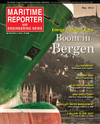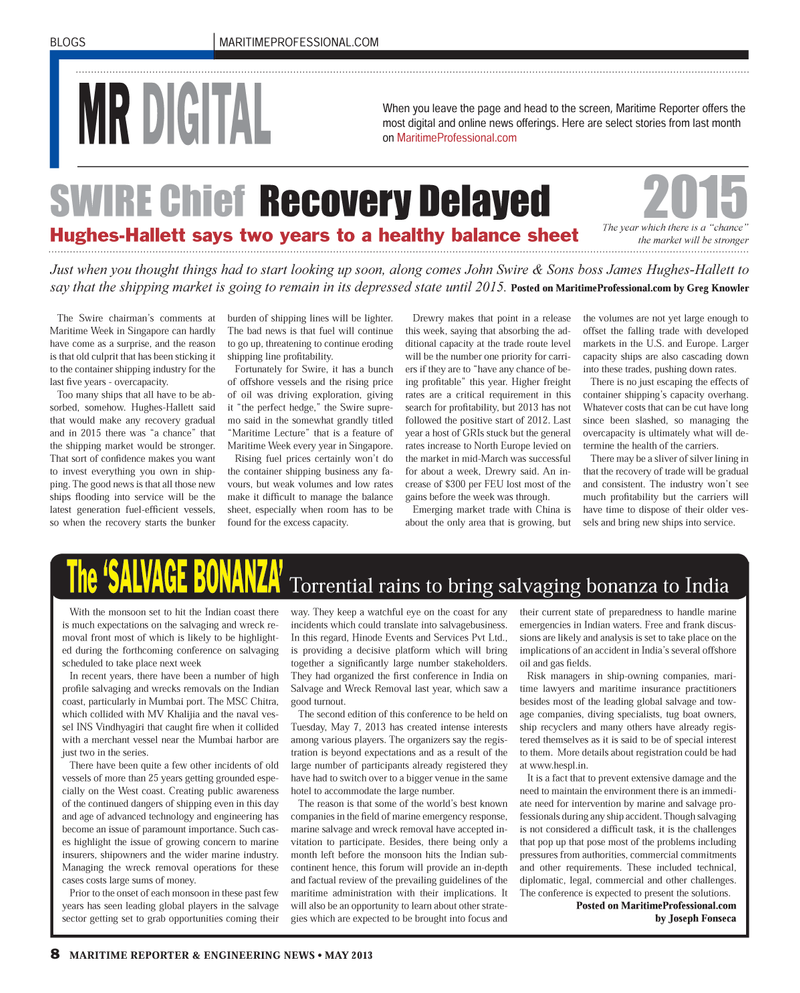
Page 8: of Maritime Reporter Magazine (May 2013)
Energy Production & Transportation
Read this page in Pdf, Flash or Html5 edition of May 2013 Maritime Reporter Magazine
8 MARITIME REPORTER & ENGINEERING NEWS ? MAY 2013 BLOGSMARITIMEPROFESSIONAL.COMThe Swire chairman?s comments at Maritime Week in Singapore can hardly have come as a surprise, and the reason is that old culprit that has been sticking it to the container shipping industry for the last Þ ve years - overcapacity. Too many ships that all have to be ab- sorbed, somehow. Hughes-Hallett said that would make any recovery gradual and in 2015 there was ?a chance? that the shipping market would be stronger. That sort of conÞ dence makes you want to invest everything you own in ship-ping. The good news is that all those new ships ß ooding into service will be the latest generation fuel-efÞ cient vessels, so when the recovery starts the bunker burden of shipping lines will be lighter. The bad news is that fuel will continue to go up, threatening to continue eroding shipping line proÞ tability. Fortunately for Swire, it has a bunch of offshore vessels and the rising price of oil was driving exploration, giving it ?the perfect hedge,? the Swire supre-mo said in the somewhat grandly titled ?Maritime Lecture? that is a feature of Maritime Week every year in Singapore. Rising fuel prices certainly won?t do the container shipping business any fa-vours, but weak volumes and low rates make it difÞ cult to manage the balance sheet, especially when room has to be found for the excess capacity. Drewry makes that point in a release this week, saying that absorbing the ad-ditional capacity at the trade route level will be the number one priority for carri-ers if they are to ?have any chance of be-ing proÞ table? this year. Higher freight rates are a critical requirement in this search for proÞ tability, but 2013 has not followed the positive start of 2012. Last year a host of GRIs stuck but the general rates increase to North Europe levied on the market in mid-March was successful for about a week, Drewry said. An in- crease of $300 per FEU lost most of the gains before the week was through.Emerging market trade with China is about the only area that is growing, but the volumes are not yet large enough to offset the falling trade with developed markets in the U.S. and Europe. Larger capacity ships are also cascading down into these trades, pushing down rates.There is no just escaping the effects of container shipping?s capacity overhang. Whatever costs that can be cut have long since been slashed, so managing the overcapacity is ultimately what will de-termine the health of the carriers.There may be a sliver of silver lining in that the recovery of trade will be gradual and consistent. The industry won?t see much proÞ tability but the carriers will have time to dispose of their older ves-sels and bring new ships into service.MR DIGITAL When you leave the page and head to the screen, Maritime Reporter offers the most digital and online news offerings. Here are select stories from last month on MaritimeProfessional.comSWIRE Chief Recovery Delayed Hughes-Hallett says two years to a healthy balance sheetThe ?SALVAGE BONANZA? Torrential rains to bring salvaging bonanza to India 2015The year which there is a ?chance? the market will be stronger Just when you thought things had to start looking up soon, along comes John Swire & Sons boss James Hughes-Hallett to say that the shipping market is going to remain in its depressed state until 2015. Posted on MaritimeProfessional.com by Greg Knowler With the monsoon set to hit the Indian coast there is much expectations on the salvaging and wreck re-moval front most of which is likely to be highlight-ed during the forthcoming conference on salvaging scheduled to take place next weekIn recent years, there have been a number of high proÞ le salvaging and wrecks removals on the Indian coast, particularly in Mumbai port. The MSC Chitra, which collided with MV Khalijia and the naval ves- sel INS Vindhyagiri that caught Þ re when it collided with a merchant vessel near the Mumbai harbor are just two in the series. There have been quite a few other incidents of old vessels of more than 25 years getting grounded espe-cially on the West coast. Creating public awareness of the continued dangers of shipping even in this day and age of advanced technology and engineering has become an issue of paramount importance. Such cas-es highlight the issue of growing concern to marine insurers, shipowners and the wider marine industry. Managing the wreck removal operations for these cases costs large sums of money. Prior to the onset of each monsoon in these past few years has seen leading global players in the salvage sector getting set to grab opportunities coming their way. They keep a watchful eye on the coast for any incidents which could translate into salvagebusiness. In this regard, Hinode Events and Services Pvt Ltd., is providing a decisive platform which will bring together a signiÞ cantly large number stakeholders. They had organized the Þ rst conference in India on Salvage and Wreck Removal last year, which saw a good turnout. The second edition of this conference to be held on Tuesday, May 7, 2013 has created intense interests among various players. The organizers say the regis- tration is beyond expectations and as a result of the large number of participants already registered they have had to switch over to a bigger venue in the same hotel to accommodate the large number. The reason is that some of the world?s best known companies in the Þ eld of marine emergency response, marine salvage and wreck removal have accepted in-vitation to participate. Besides, there being only a month left before the monsoon hits the Indian sub-continent hence, this forum will provide an in-depth and factual review of the prevailing guidelines of the maritime administration with their implications. It will also be an opportunity to learn about other strate-gies which are expected to be brought into focus and their current state of preparedness to handle marine emergencies in Indian waters. Free and frank discus- sions are likely and analysis is set to take place on the implications of an accident in India?s several offshore oil and gas Þ elds.Risk managers in ship-owning companies, mari-time lawyers and maritime insurance practitioners besides most of the leading global salvage and tow-age companies, diving specialists, tug boat owners, ship recyclers and many others have already regis-tered themselves as it is said to be of special interest to them. More details about registration could be had at www.hespl.in. It is a fact that to prevent extensive damage and the need to maintain the environment there is an immedi-ate need for intervention by marine and salvage pro-fessionals during any ship accident. Though salvaging is not considered a difÞ cult task, it is the challenges that pop up that pose most of the problems including pressures from authorities, commercial commitments and other requirements. These included technical, diplomatic, legal, commercial and other challenges. The conference is expected to present the solutions.Posted on MaritimeProfessional.com by Joseph FonsecaMR #5 (1-9).indd 8MR #5 (1-9).indd 85/2/2013 2:14:12 PM5/2/2013 2:14:12 PM

 7
7

 9
9
